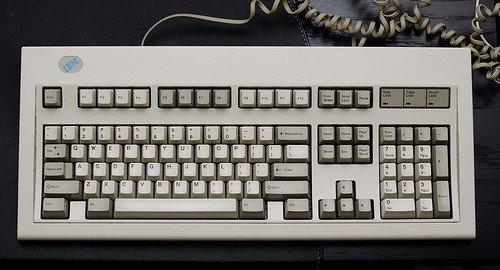How I Fell in Love with the M-Type, IBM’s Phenomenal Keyboard, Recently Crowned by The Verge as the “Best Keyboard Ever Made”
My first computer was a Sinclair ZX81, which I bought with my summer job money in 1981, just before my enlistment. It had a mere 1 kilobyte of RAM, a 12-inch black and white TV served as the monitor, a cassette tape acted as a storage device (hard disks were not yet common), and a touch-type keyboard. After minimal use, the keys became unresponsive, turning typing into a nightmare where you never knew if the keystroke would appear on the screen or execute the correct action – or not. This experience traumatized me, and I still can’t shake it off more than thirty years later.
A computer keyboard is like the steering wheel of a car. It is the primary accessory through which we control and navigate the computer, which is perhaps why most raged attacks against computers focus on destroying the keyboard.
During my military service, I worked with a Kaypro computer, where I was first introduced to a keyboard with tactile keys and learned that there could be another way. In the following years, my need for a quality keyboard became almost obsessive. I tried many types of keyboards, including those of the DEC Rainbow 100 during my early years at the Technion, but they all left me disappointed, until I met the one.
It wasn’t love at first sight. The IBM Personal System/2 computer, to which the M-Type keyboard was connected via a coiled cable, was not a great success, but the M-Type keyboard that came with it triumphed over all. With its unique hard sound, pleasant and precise key action, and wide backspace and shift keys that made typing much easier, it set a new standard. Although it lacked ergonomic features, its weight and bulkiness prevented it from moving on the desk, an ergonomic advantage in itself. By the way, its weight of about 1 kg and the fury of a warrior attacking with this keyboard could be deadly.
IBM’s engineering and human factors, combined with high-quality materials, were impressive in every aspect. All of these, along with the mechanism and structure of the keys, have made the M-Type what it is today – the King of Click. The only drawback I dare to mention is the lack of a Win key. Although such keyboards with a Win key are now being manufactured, I manage quite well with the Ctrl-Esc combination as a substitute for the missing key.
The M-Type is still considered the queen of keyboards today and is defined as a classic. Accordingly, its price is high. Such a keyboard is still being produced and sold today at a price of around $100 per unit.

I am proud to declare myself the owner of four such keyboards. I bought them in 1993 from the “Big” electronics recycling business in the industrial zone of Kiryat Bialik, which specializes in electronic waste. When I rummaged through piles of old computers, most of them from Rafael, I found a box with five M-Type keyboards. Unfortunately, one of them was damaged by an unidentified chemical substance, but the other four were sold to me at an absurdly low price of 25 NIS per keyboard.
The keyboards underwent conversion processes according to the generation of the connection method, from the first IBM PC with a DIN connector, to PS/2, and up to today’s wireless USB.
Today, I use two out of the four (one at the office and the other at home), one I bequeathed to my eldest son, who developed a personal connection similar to mine with this keyboard. The fourth keyboard, kept in a sealed box, awaits its day. I have reasonable grounds to believe that the existing stock will faithfully serve me until my retirement and even beyond. During the writing of the book on the history of personal computers, a subject that has fascinated me for many years, both as a professional writer and as a hobbyist historian.
In these days when certain types of phones boast that this email you are reading was sent through them, I would like to sign, but this time with a request line that could appear at the end of any document ever created with the help of this wonderful keyboard.
This document was written on an IBM M-Type keyboard.

